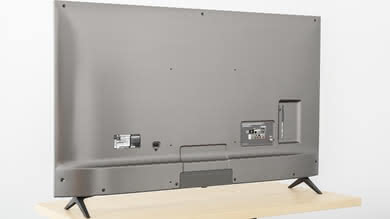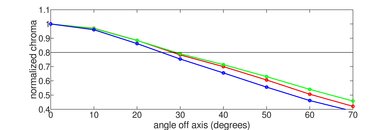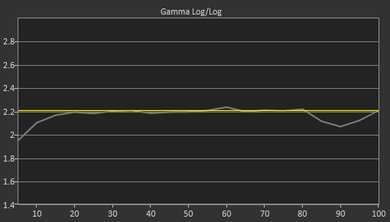Our Verdict
The LG UK7700 is a very good TV for mixed usage as it can handle reflections well, making it suitable for bright rooms even though the TV does not get too bright. Motion handling is decent and the TV can perform very well with video games and as a PC monitor due to its excellent low input lag.
- Feels very responsive due to excellent input lag
- Image remains accurate at an angle
- Blacks are gray and blotchy in a dark room
- Mediocre HDR support
This LG UK7700 has a mediocre performance when watching movies. In dark environments, the not so good contrast ratio does not make blacks look deep and the local dimming cannot help. The TV can display Blu-ray at 1080p and native 4k content well but its black uniformity might be an issue for some movie enthusiasts.
The performance of the LG UK7700 when watching TV shows is great. It has excellent reflection handling, decent SDR Peak Brightness, and ok viewing angles. When upscaling from the cable 720p input the UK7700 does a good job and the motion interpolation option can add some soap opera effect for those who like it.
The LG UK7700 is very good for watching sports. The good reflection handling and very good response time, along with decent SDR Peak Brightness, make it suitable for a relatively bright room and fast action content. The viewing angles are ok for a wide room and some sports fan might notice a little dirty screen effect on panning shots.
The LG 65UK7700 is very good for video game playing. It has an outstanding low input lag and great response time that will keep most gamers happy. It can accept most common input signals and its motion handling is decent. Make sure you enable the Game picture mode to enjoy the low input lag.
Watching HDR movies on this TV is mediocre. This is mainly due to sub-par contrast and the bad local dimming, which do not allow the TV to display deep blacks in dark environments. Although the 4k content is displayed well the HDR brightness is not enough to reveal the content as intended by the content creator.
This TV is good for playing HDR games It has very low input lag at 4k @ 60Hz + HDR, and because of its fast response time it a great choice for those who want to use it to play HDR games, although the not so good contrast will make blacks appear a little washed out and the colors will not be so vivid.
This a great TV for use as a PC monitor. The very low input lag and the good response time will make the PC usage experience a good one. Also if you wish to use this TV as a PC monitor you do not have to worry about the permanent burn-in risk or temporary image retention.
Changelog
- Updated May 21, 2020: Converted to Test Bench 1.5.
- Updated Feb 21, 2020: Converted to Test Bench 1.4.
- Updated Feb 28, 2019: Converted to Test Bench 1.3.
- Updated Jul 03, 2018: Review published.
Check Price
Differences Between Sizes And Variants
We tested the 65" (65UK7700PUD). For the most part, we expect our review to be valid for the 49" (49UK7700) and the 55" (55UK7700).
| Size | US | Canada (and US warehouse) |
| 49" | 49UK7700PUD | 49UK7700AUB |
| 55" | 55UK7700PUD | 55UK7700AUB |
| 65" | 65UK7700PUD | 65UK7700AUB |
If someone comes across a different type of panel or if their LG UK7700 doesn't correspond to our review, let us know and we will update the review.
Popular TV Comparisons

The LG UK7700 is a TV that is ok for most usages without standing out for a specific characteristic. See our recommendations for the best 4k TVs and the best TVs.
The LG UK7700 is a better TV than the Samsung NU7100. The LG has better reflection handling, better response time, and wider viewing angles due to its IPS panel, so watching sports and TV shows on the LG is a very good experience. On the other hand, the Samsung NU7100 will offer a better experience in HDR movies due to the much better contrast ratio that can produce deep blacks in a dark room.
If you have a room with a wide seating arrangement, then the LG UK7700 is a better choice as the image remains accurate when viewed at an angle. If, however, you sit straight in front of the TV and watch movies in a dark room, then the Samsung NU8000 is a much better choice as it has a higher contrast ratio and can display deep uniform blacks, enhancing the picture quality. The Samsung NU8000 can get brighter to fight bright room glare and supports FreeSync for tear-free gaming sessions. The LG UK7700 has better reflection handling and a lower input lag, which is great for playing video games.
The two TVs have different panel types. The LG UK7700 has better viewing angles, better reflection handling and is more appropriate for watching sports or TV shows in a room with many light sources and wide seating arrangement. The Vizio E Series 2018, on the other hand, is a better choice for a dark room where you will be sitting right in front. It has better contrast ratio, better black uniformity, and will provide a better movie experience in a dark room and better HDR performance.
The LG SK8000 and the LG UK7700 have very similar performance. The LG SK8000 can remove 24p judder from movies better than the UK7700 can and can interpolate motion to higher fps than the UK7000. Also, the black frame insertion feature of the SK800 works better than the UK7700 and can make the image crisper. The LG UK7700, on the other hand, has lower input lag both in SDR and HDR and is great for gaming.

We buy and test dozens of TVs yearly, taking an objective, data-driven approach to deliver results you can trust. Our testing process is complex, with hundreds of individual tests that take over a week to complete. Most of our tests are done with specially designed test patterns that mimic real content, but we also use the same sources you have at home to ensure our results match the real-world experience. We use two main tools for our testing: a Colorimetry Research CR-100 colorimeter and a CR-250 spectroradiometer.
Test Results
The design of the LG UK7700 is good. It has a nice metallic finish. The stand is wide and supports the TV well. It is a relatively thin TV that will not protrude much if wall-mounted but you might have a hard time reaching some of the inputs that are in the back and are facing outwards. The build quality is good and should not cause any issues.
The rear of the TV is plain. Some of the inputs face directly out the rear of the TV and these may be hard to reach if it is wall mounted.
There is no cable management.Poor local dimming performance on most scenes. It cannot make the blacks look deeper. Local dimming on the TV is implemented with a limited number of vertical zones since the TV is edge-lit. This has limitations in the effectiveness of local dimming. To compensate for that the algorithm is aggressive and dims the whole screen making the smaller highlights almost disappear. It is however less aggressive than the SJ8500. We recommend that you keep it on medium and if you think that the local dimming is not working to your liking, you can turn it off or simply set it to 'Low'.
Decent peak brightness, good enough for dim rooms but not enough to allow the TV to overcome glare. The TV sustains similar brightness across a number of window sizes and this is great.
The HDR peak brightness is mediocre. The TV boosts small highlights but the brightness is just not enough to display the creator's intention and take advantage of the HDR increased brightness range. A definite setback compared to last year's UJ7700.
The LG UK7700 has a good gray uniformity. In the 50% gray test picture, it is slightly darker on the sides and especially at the corners. The image uniformity at the center is a little better and although one can still notice minor dirty screen effect, it will not bother you much when you use the TV for sports viewing.
In the 5% image the uniformity is very good with no noticeable clouding.
The LG 65UK7700 has a mediocre viewing angle. It is one of the worst IPS panels, but still better than almost all VA TVs. Blacks remain black, as you move away from the central angle but the colors shift and brightness washes out. Last year's UJ7700 had a very similar viewing angle.
The black uniformity of the LG UK7700 is poor. Clouding is scattered all over the image and there are areas where the black looks more like deep gray. When the local dimming is enabled, there is a gray stripe in the center of the screen defined by the horizontal line of the test cross. This not only reveals the local dimming capabilities of the TV, but also is causing even more black uniformity issues. This is a very similar behavior to last year's UJ7700 model.
The TV is great at handling reflections. The semi-gloss finish diffuses reflections across the screen, reducing their intensity. This should is great as the TV can be placed both in average lit rooms and in bight ones.
The LG UK7700 has very good out of the box color accuracy. When the picture mode is set to Expert (Dark Room), the color dE is almost at 3, so a few people might notice slight imperfections and the white balance dE is well below 3 were people might notice some inaccuracy.
The gamma is at 2.09 making shadows look slightly darker, but again only a few people will notice. The color temperature is almost on target and just slightly off to the warm side.
The post calibration color accuracy is excellent, even though it's not easy to achieve. The gamma was flattened to almost match the 2.2 target.
We were not able to completely correct the color dE even though we were able to reduce it. On the other hand, the white balance dE was almost zeroed. Finally, the color temperature stabilized more closely to the 6500K target due to the improved white balance.
You can see our recommended settings here.
The color gamut of this TV is decent, but it fails to pass the 67% mark of the Rec. 2020 uv color space coverage for us to classify it as having a wide color gamut.
In the Cinema HDR picture mode, when the TV is sent our normal 10,000 cd/m² HDR infoframe, its EOTF massively undershoots the target PQ curve, making HDR content appear far dimmer than intended. Fortunately when the TV is sent a 1,000 cd/m² HDR infoframe, its EOTF is much brighter, though still not great. This means that some content will be shown with a fairly accurate brightness, while other content will be shown far dimmer than intended. If you find HDR content too dim, setting Dynamic Tone Mapping to On and setting Dynamic Contrast to High brightens the EOTF somewhat, as shown here with the 10,000 cd/m² HDR infoframe. The Game picture mode unfortunately shows the same EOTF dimming as Cinema.
The color volume on this LG UK7700 is sub-par. This is mainly due to the limited color gamut, that does not allow the TV to display dark shades of colors as it fails to cover either color space well.
Although some IPS panels can suffer from temporary image retention, this doesn't appear to be permanent as the IPS panel in our long-term test appear immune.
The response time is great and results in only a small trail following fast moving objects. It is an improvement over the UJ7700.
TheLG 65UK7700 does not have an optional BFI, but because the backlight flickers at 120Hz, it does help motion look more clear.
Motion interpolation on the UK7700 is decent. It is nearly perfect during slow-moving shots. When at the De-judder is set to max, the TV does not stop interpolating even during fast motion, so some artifacts are present. If you find that interpolation produces too many artifacts, we recommend you lower the value of De-Judder so that motion interpolation becomes less aggressive and produces less artifacts
The LG UK7700 is decent at displaying content without stutter. In low fps content such as 24p movies, you will notice some stutter as the TV response time is quite fast. If you find that bothersome, you can enable motion interpolation to reduce it.
The LG 65UK7700 can play 24p content without judder, but only when played from a native 24p source like a Blu-ray player or from the native apps. To remove judder turn on Real Cinema.
When the 24fps content is coming through 60i or 60p then the TV is not able to remove it.
This TV doesn't support variable refresh rate.
Remarkable low input lag. When Game mode is activated, the TV bypasses all processing. This is among the best input lag we have tested up to date.
Chroma 4:4:4 is only shown properly in the PC input mode and unlike many other LG TVs, the Game picture mode is still required when in the PC input mode in order to have the lowest input lag.
The most common resolutions are supported on the LG UK7700. However, 1440p is not supported, although 1080p @ 120Hz is accepted by the TV, it is not displayed properly as this is a 60Hz panel and drops every second frame.
4:4:4 Chroma is only properly displayed when the input icon is set to PC mode and the signal is RGB as YCbCr will not correctly display.
When in PC Mode with HDR enabled, the TV does not properly support 4:4:4 color and colors appear washed out.
In PC Mode, Sharpness at 0 means no added sharpness.
4k @ 60Hz @ 4:4:4 or 4:2:2 is only supported when HDMI Ultra HD Deep Color is enabled
The frequency response of the UK700 is average. LFE (low-frequency extension) is at 80Hz, which is decent. This means that this TV will have some punch to its bass, but won't be able to produce sub-bass, which is responsible for thump and rumble The response above the LFE point is quite good, which is important for producing intelligible dialogue. However, this TV gets only decently loud and produces some pumping and compression artifacts under heavy loads. Also, its room correction system (Magic Sound Tuning) wasn't able to remove the modes of our test room around 200Hz.
The distortion performance of the UK7700 is about average. The overall amount of THD produced is not very high at 80dB SPL, and there is not jump in THD under maximum volume either. However, this TV doesn't get very loud.
The webOS interface is similar to other 2018 LG models like the SK9500. It includes the improved search functionality and the menu is very responsive.
We did not see any ads during testing. However, we have found ads on other 2018 LG TVs as shown here, so we assume all 2018 LG TVs have ads.
The TV comes preloaded with many popular apps such as Netflix, YouTube and Amazon Video. In the LG Content Store, you can find many more apps and content
The remote is identical to the one found on all high-end LG TVs like the C8 and SK9500. It gives you quick access to the most common TV functions and can also be used as a pointer to navigate the menus and even has a scroll wheel integrated into the d-pad.
The remote also works for voice commands and the TV can perform basic commands such as change inputs, open YouTube, or search Netflix, but it cannot change the settings i.e 'Change backlight to 5' won't work.
You can also set a sleep timer and perform more advanced searches like checking the weather or answering basic searches. Some searches are answered by LG's proprietary ThinQ AI; others were answered by Google Assistant, similar to Sony TVs like the X900F.













































